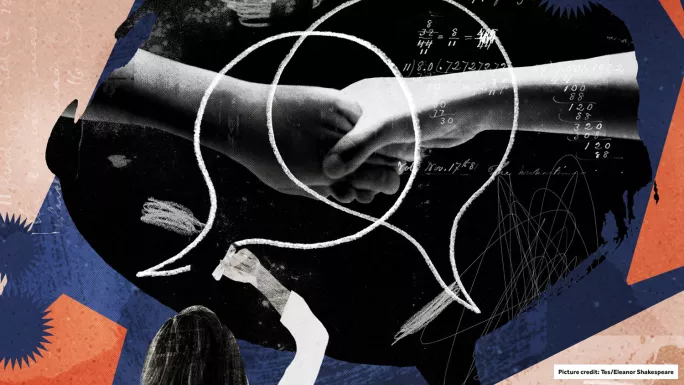- Home
- How to become a restorative school - Part 1: The case for embracing it
How to become a restorative school - Part 1: The case for embracing it

The police officer sits between the two families on one side of the circle; I sit between them on the other. The anxiety in the room is high.
It’s unsurprising: the boy to my left was hit hard enough by the boy to my right that a hospital visit was needed. His eye is still swollen, black, the lid half-closed. The police became involved. And a week later, it’s time to decide what comes next.
In many schools, the solution would be relatively straightforward. Responses to challenging behaviour are generally sanction-based; evidence of this can be seen in statistics that show, on average, that nearly 1,800 fixed-term exclusions are issued every day, totalling 339,360 in 2016. Permanent exclusions in the same year reached 6,685.
In light of the level of violence that had occurred in the case in question, permanent exclusion would likely have been the option taken in most schools. Not here, though. Here, we’re talking it out.
The conversation is carefully structured; everyone speaks in a respectful way and the level of challenge is high. Some responses are painful to listen to, but everyone takes their turn. There is no prejudged outcome; just a will to find a solution that works for all.
The Iffley Academy is a restorative school. We are one of only a few schools in the UK to have the restorative-service quality mark. And we are arguably in a situation where such an approach is more challenging than most: we are a special school with 150 learners, over 40 per cent of whom have social, emotional and mental health (SEMH) difficulties; 50 per cent are eligible for pupil premium; many have communication and interaction difficulties; and all have cognition and learning difficulties.
We have used a restorative approach for 14 years. We believe it works. And we believe it could work elsewhere, too.
What is restorative justice?
Restorative approaches in schools have grown out of work in the youth justice system. It is a way of working that recognises the harm that has been caused, and it aims to repair relationships. The repair takes place through restorative actions, such as repairing harm or damaged property, taking the time to develop an understanding of those who have been hurt and working together to identify new ways to interact.
As the Restorative Justice Council explains: “Restorative approaches give those affected by harm an opportunity to meet with the wrongdoer, and for them to play a part in repairing the harm and finding a positive way forward.” Contrary to the perception of some, it’s much more complex than just talking about what went wrong.
Restorative approaches allow adults to model emotional literacy and develop the student’s empathy, so that their drive to behave in a negative way is challenged not by sanctions, but by the impact the behaviour has on others in society. It is not about using fear to force a person to change behaviour or make amends, but instead using structured conversation to make them accountable for what they choose to do.
Admittedly, this can be hard work and the expectation within schools such as the Iffley Academy is for the students involved to do that work. Pupils in this system do not receive detentions or other punitive actions, and exclusions are rare. When conflict is encountered, staff use their restorative training, research and knowledge to resolve conflict, carefully considering the needs of the young people, their backgrounds and prior behavioural interactions.
Upon reading this, some teachers will no doubt be labelling the system “soft” or “unsupportive” (you see these comments a lot among teachers when restorative approaches are discussed). But detentions and exclusions do not make students accountable for behaviour - they simply provide feedback for a specific action. If they did work, our exclusion rates would not be so high; those same children would not be in trouble each time; and our alternative-provision sector would not be full to bursting point. We are not changing behaviours with sanctions. They are a simple and basic response, not the professional, considered interaction that should be expected of a teacher.
Moreover, if a young person is hurt in an interaction and an exclusion has been issued to the wrongdoer, what work is being done to support either of the children’s emotions or their right to reply? You have taken the power of change away from them both. A restorative culture ensures all parties are heard. The approach puts the responsibility not in the hands of teachers, but in the hands of those that have been hurt and those that caused hurt.
A common myth about restorative practice is that it is some new-age, light-touch approach in which there are no rules or boundaries. On the contrary, in this system, rules and boundaries need to be even clearer. To work in a restorative way, individuals have to be ready, they need to be safe from harm’s way and they must understand the boundaries. The responsibility of the adults is to ensure that students are staying within those boundaries and that they are accountable for their behaviour.
Such a system requires an intelligent approach. In a punitive system, you know the rules and apply the sanctions, but in a restorative system, it is about the students knowing the rules because they believe in them. They understand why the rules are in place, they invest in relationships and it actually matters to them if they or their peers break the rules.
Break and make
The strongest evidence for the approach as a whole comes from the justice system, where it has been used extensively for some time. Prisoners engaging with restorative justice are 14 per cent less likely to reoffend.
In a 2017 Restorative Justice Council report, Restorative Justice and Prison, Rosie Olliver notes: “The largest study into this was a UK government-funded £7 million, seven-year randomised control trial in 2001-08. It looked at the use of restorative justice alongside the criminal justice process, rather than as a diversionary measure, including with offenders who were serving prison sentences.”

Oliver then quotes a prisoner involved in the approach and his testimony is telling: “Going to prison, that’s just running away from it all. But to go into a room and sit down knowing that they’re going to walk through that door in a few minutes and want to know why you stole from them - that’s scary for me. It kind of broke me, but it made me as well.”
The largest studies in schools have been carried out in Australia and New Zealand. These found that truancy and exclusions were reduced, and the relationships with staff and parents were greatly improved (Buckley and Maxwell, 2007). A report published in 2014 by the Department for Education gave whole-school restorative approaches the highest rating of effectiveness at preventing bullying; when schools were surveyed, 97 per cent of them rated restorative approaches as highly effective (DfE, 2014).
At the Iffley Academy, there were no permanent exclusions in 2016-17. On average, in 2016, less than 1 per cent of incidents at the academy were related to bullying and 0.32 per cent involved racism. For those pupils who were most involved in bullying, bullying only made up 7 per cent of their individual challenging behaviours across the year. With staff addressing behaviour, incidents became less frequent and less likely to occur as the year progressed.
Of course, the research - or our own experience at the Iffley Academy - won’t convince some people, but to them I ask: how far is your current system evidence-based in comparison? Particularly when it comes to children with special educational needs and disability (SEND).
Pupils with SEND are eight times more likely to be permanently excluded from school, and those with SEMH difficulties are the most likely - with 79,935 fixed-term exclusions passed down in 2015-16.
Jarlath O’Brien, in What Does This Look Like in the Classroom? (Hendrick and Macpherson, 2017), sets out three key reminders when working with students with SEMH:
* Remember that communication is an unmet need: between 35 per cent and 50 per cent of children with speech, language and communication difficulties also have behavioural difficulties.
* Behavioural difficulties are skills gaps that need to be filled, much like we do when we teach reading and writing.
* Punishments and sanctions are ineffective, and restorative approaches work best.
Knowing that these young people are at high risk of exclusion, shouldn’t we be using a restorative approach to support them towards better outcomes?
Back at the Iffley Academy, the outcomes for the two families are clear. The behaviour has been officially recorded by the police and it is clearly understood that an arrest is likely in the event of a reoccurrence. The school has challenged the behaviour and it is clear that it will not be accepted.
The student has heard about the impact on others and how it has affected both families. The mother of the boy with the bruised face has recounted her highly anxious trip to A&E, the sickness in her stomach at receiving the phone call from the school, and how confronting the wrongdoer has changed the way she is feeling. The opportunity for her and her child to face up to him has led her to understand his behaviour was a form of communication.
This acceptance and understanding draws the offending boy to tears; at the end, his apology is sincere, his body language passive and he gets up from his chair to embrace her and her son.
Will it ever happen again? Possibly. Is it less likely to happen again owing to the restorative approach? Evidence suggests so, and that the future actions of those children involved will be significantly affected by the work we have done.
Tom Procter-Legg is assistant headteacher at the Iffley Academy, Oxfordshire
Next week: We unpack the whole-school approach to restorative justice and ask the question: what does it take to become a restorative school?
Keep reading for just £1 per month
You've reached your limit of free articles this month. Subscribe for £1 per month for three months and get:
- Unlimited access to all Tes magazine content
- Exclusive subscriber-only stories
- Award-winning email newsletters


